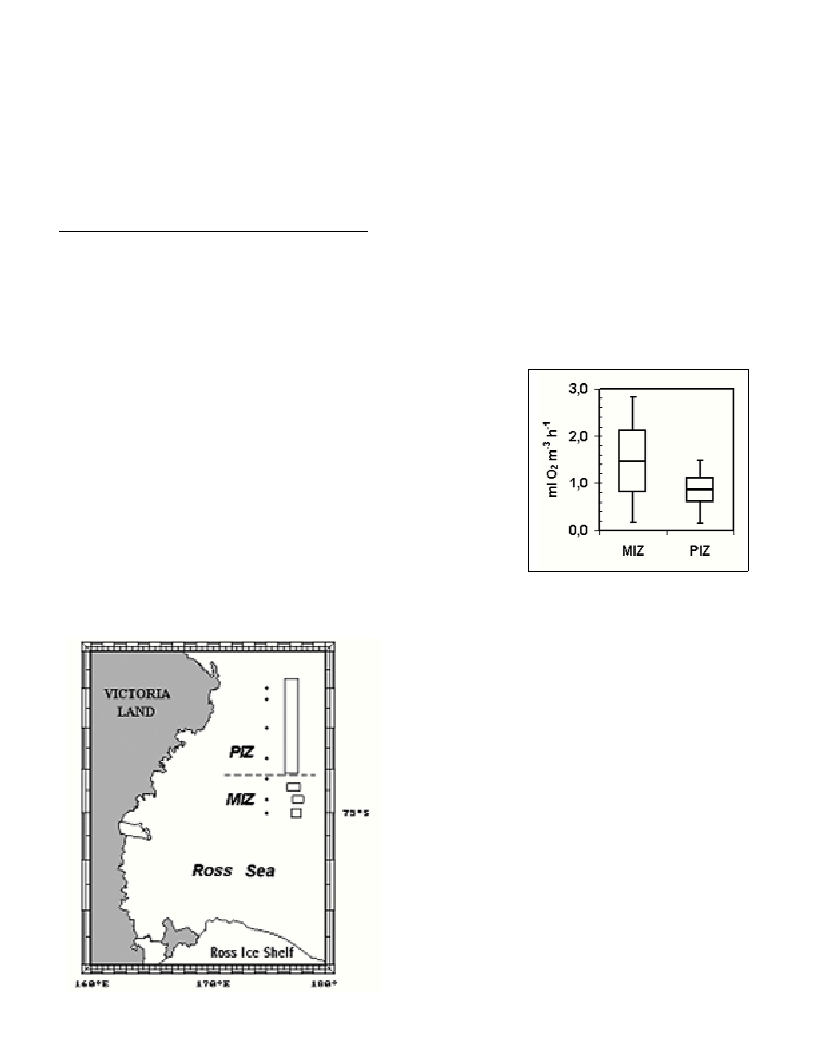SPATIAL VARIABILITY OF MICROPLANKTON RESPIRATION
IN THE ROSS SEA (ANTARCTICA) DURING AUSTRAL SPRING
Azzaro M.
1*
, La Ferla R.
1
, Ribera d’Alcalà M.
2
1
IAMC-CNR, section of Istituto Sperimentale Talassografico, Messina, Italy, dedalus@ist.me.cnr.it
2
Laboratorio di Oceanografia Biologica (SZN), Naples, Italy
Abstract
Respiratory electron transport system (ETS) measurements of the microplankton were performed along a south-north transect from the
marginal ice zone (MIZ) to the pack ice-covered zone. ETS activity ranged from 0.14 to 1.47 ml O
2
h
-1
m
-3
(mean value ±SD: 0.85 ±0.35
ml O
2
h
-1
m
-3
) under the ice and from 0.17 to 2.81ml O
2
h
-1
m
-3
(mean value ±SD: 1.47 ±0.80 ml O
2
h
-1
m
-3
) in the marginal ice zone.
The MIZ ecosystem was net autotrophic (P/R>1) while the pack ice zone was net hetertrophic (P/R<1).
Key-words: Ross Sea, ice-melting, microplankton, respiration
Rapp. Comm. int. Mer Médit., 37,2004
263
Introduction
Our knowledge on ecosystem metabolism of polar region is still
rather poor compared to that of temperate latitudes. Recently this gap
has been filled by several studies both in Antarctic and Arctic waters
(1, 2, 3). However, little information is available regarding the impact
of retreating pack-ice zone on remineralization processes and the
balance between photosynthesis and respiration.
Research during ROSSMIZE cruise focused on the sea ice-covered
zone and its northern edge during early spring. The aim of this study
was to measure respiratory activity of microplankton in the water
column under the pack-ice zone and in the marginal ice zone (MIZ),
in order to improve the understanding of respiratory losses of newly
formed organic carbon in these two subsystems.
Material and methods
The ROSSMIZE cruise was carried out from 16 November to 16
December1994, on board the R/V Italicain the Ross Sea (Fig. 1).
Microbial respiratory activity (<200
µ
m) was determined according
to the ETS (Electron Transport System) assay, corrected to in situ
temperature using an Arrhenius activation energy of 11 Kcal mol
-1
(4)
and converted to carbon dioxide production rates using a respiratory
quotient of 1 (1). Sampling depths were selected according to optical
levels (50, 20, 10, 5, 1 and 0.1% of incident irradiance) in the upper
100 m using a SBE 32/24 Carousel; a surface sample was also
included.
Results and discussion
On the base of pack-ice cover, two main zones were distinguished
on different spatial scales along a S-N transect: an area with pack-ice
in its northern part (PIZ) and the marginal-ice zone (MIZ) in the
southernmost part, characterized by drifting fragmented ice (Fig. 1).
Fig.1. Map of sampling locations and pack ice typology.
In the PIZ, characterized by a prevalence of microphytoplankton
(5), ETS activity ranged from 0.14 to 1.47 ml O
2
h
-1
m
-3
(mean value
±SD: 0.85 ±0.35 ml O
2
h
-1
m
-3
). A higher ETS activity was found in
the MIZ (range: 0.17 to 2.81ml O
2
h
-1
m
-3
; mean value ±SD: 1.47 ±
0.80ml O
2
h
-1
m
-3
) where the picoplankton prevailed. The median
ETS activity was 0.93 ml O
2
h
-1
m
-3
for the PIZ subsystem and
1.47ml O
2
h
-1
m
-3
in the MIZ (Fig.2). Mean depth integrated values
of ETS activity in the PIZ and the MIZ were as mean 77.9 and 117.2
ml O
2
h
-1
m
-2
, respectively, confirming the different respiratory levels
calculated on meter
cubic basis. All the-
se values fall in the
same range of other
published data for
polar regions (2).
The different le-
vels of respiratory
activity observed in
the two subsystems
were statistically
different (ANOVA
test: MIZ versus
PIZ p<0.01) and
re?ected the spatial
variations of phyto-
plankton biomass
and productivity
determined on the
same cruise (5).
ETS activity correlated (r=0.42; n=44) with primary production (5),
revealing a coupling between productive and consumptive processes
according to previous field studies in the Antarctic Ocean (1, 3). With
the aim to determine the overall system’s metabolism of the two
subsystems, the ratio between photosynthesis and respiration (P/R)
was calculated. Our results show a different scenario for the MIZ and
the PIZ, with ratios P/R=1.9 and P/R=0.3, respectively. These results
are consistent with that of Martinez and Estrada (1) reported for the
ice edge and below the ice cover of the Wedell Sea.
In conclusion this study indicates that: A) Levels of respiratory
activity are lower under the ice and enhanced in the MIZ. B) The MIZ
ecosystem was net autotrophic (P/R>1) while the PIZ was net
heterotrophic (P/R<1) during the investigation period.
References
1-Martinez R., and Estrada M., 1992. Respiratory electron transport
activity of microplankton in the Weddel Sea during early spring: in?uence
of the ice cover and the ice edge. Polar Biology, 12: 275-282.
2-Arìstegui J., and Montero F., 1995. Plankton community in Bransfield
Strait (Antarctic Ocean) during austral srping. Journal of Plankton
Research,17: 1647-1659.
3-Estrada M., Martinez R., and Mathot S., 1992. Respiratory electron
transport system activity in microplancton of the Weddel and Scotia Seas
during late spring-early summer. Relationschips with other biological
parameters. Polar Biology,12: 35-42.
4-Packard T.T., and Williams P.J. leB, 1981. Rates of respiratory oxygen
consumption and electron transport in surface sea water from the
northwest Atlantic. Oceanologica Acta, 4: 351-358.
5-Saggiomo V., Carrada G.C., Mangoni O., Ribera d’Alcalà M., and
Russo A., 1998. Spatial and temporal variability of size-fractioned
biomass and primary production in the Ross Sea (Antarctica) during
austral spring and summer. Journal of Marine Systems, 17: 115-127.
Fig.2. Box-and-whisker plots showing the range
and the median ETS activity in MIZ and PIZ.

